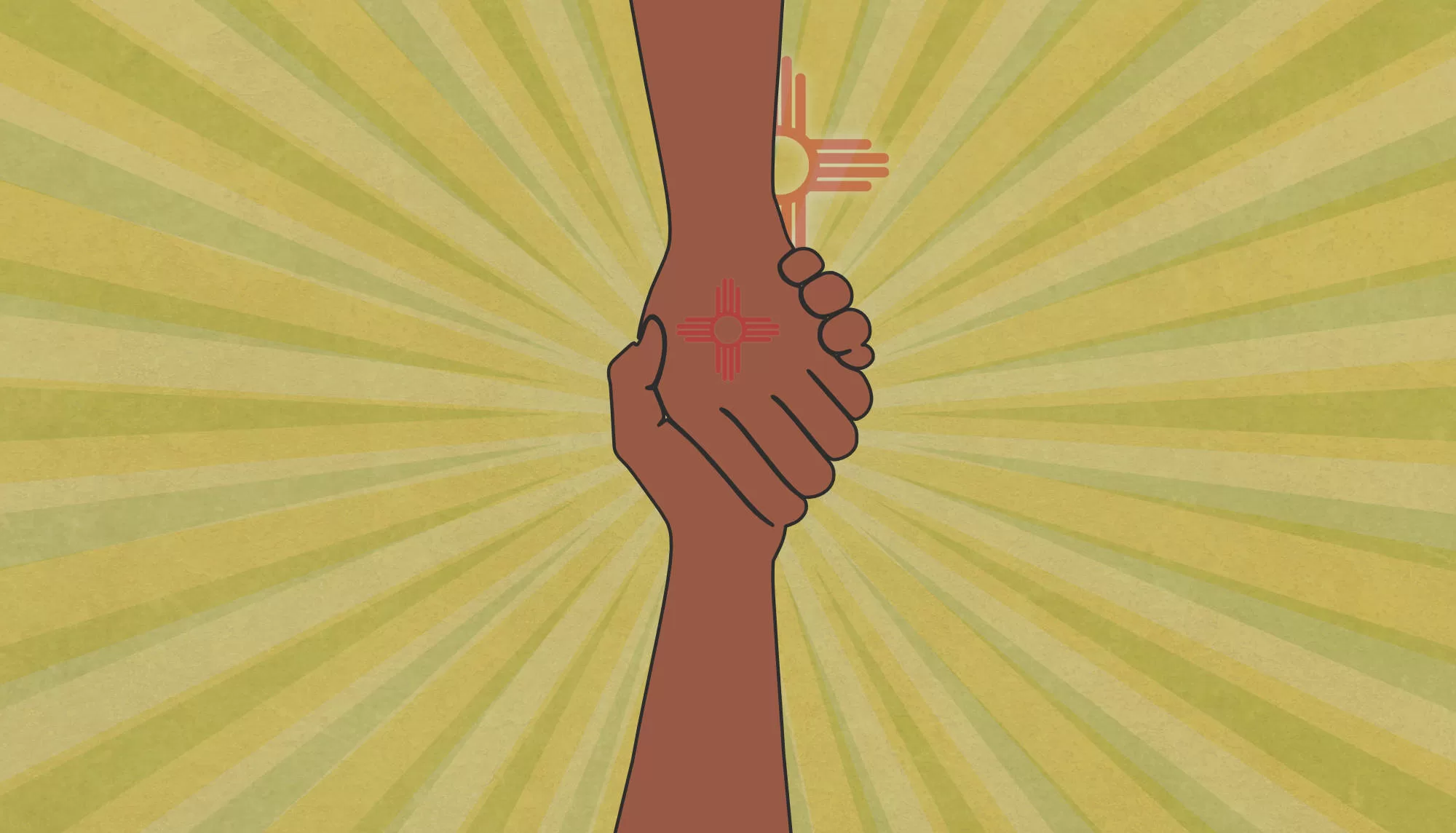Seven Steps to a Future When 100% Thrive
Exploring how each county can ensure ten vital services for surviving and thriving.
“How can you expect to ensure ten vital services for families in New Mexico when we can’t even ensure one?” This is what we have been hearing since we started the 100% New Mexico initiative. Our response is always the same, “From our countywide survey of families, they tell us they are seeking ten vital services and facing challenges accessing them.” The question is not, “Why ten services?” Our question is, “How does a county-based coalition do what’s never been done in the United States, which is to ensure that every family has access to the ten vital services for surviving and thriving?”
7 Steps: A guide to success
First, it’s important to note that each county-led 100% New Mexico initiative is locally run and customized to meet local needs. Each county has unique challenges that include adverse childhood experiences, family trauma, and social adversity in the form of lack of access to vital services. Working as coalitions with representatives from each of the ten vital services for surviving and thriving, our local initiatives are completing seven steps. These are not random activities, but a carefully planned process of assessment, planning, action, and evaluation, all guided by data and research.
Step 1: Conduct the countywide 100% New Mexico survey
This survey of families is designed to assess what percentage of families face challenges trying to access ten vital services for surviving and thriving. The survey also identities the various types of barriers to connecting with services that often include cost, inability to qualify for help with services, waiting lists, unfriendly hours, and lack of transportation. You are welcome to review our surveys on our NMSU website.
Step 2: Review survey results
This is part of the assessment analysis process, where ten action teams (each one focused on one of ten vital services) reviews why residents struggle to access services. For example, the 100% Medical/Dental action team would note that waiting times, cost, inability to find a provider, and lack of insurance are the top four barriers in their county. This information is what will guide solutions in the next planning phase.
Step 3: Assess service providers
In this process, action teams perform phone interviews with representatives of all the organizations that provide services within their sector across the county. For example, the 100% Behavioral Health action team would call all those providers of behavioral health care who offer services through a sliding-fee scale, insurance, or Medicaid and Medicare. The interview questions focus on confirming hours of operation, costs, waiting times, and any changes to services due to the pandemic.
Step 4: Create (or update) a web-based directory to ten services
Our initiative seeks to make linking family members to family-friendly services as easy as possible. An online directory for both providers and families to use helps everyone in the county get on the same page with what services truly exist. We often hear from agencies, “We refer families to services,” without their knowing if services truly are accessible within a county. Our 100% Family Services Directory is a project that county initiatives can take on if they have the capacity to keep it updated with quarterly accessibility reviews, since service agencies can go out of business, or radically change their offerings, quickly. A print version of the directory can also be easily created.
Step 5: Identify how to end service barriers
This is where the heavy lifting comes into play with the local initiative and ten action teams. Each team will review the research on how to end a service barrier. For example, the 100% Parent Supports action team can review the positive impact of creating a one-stop service hub for parents, in order to make accessing vital services easier. The team writes a proposal for a 100% Family Center that can become a one-stop shop in both rural and urban areas. All ten teams will be reviewing all types of innovations in service delivery within their sector. Technology is also of great help in all ten sectors, with many services enhanced by offering web-based help. Each county has on their to-do list: end the digital divide so all households can access web-based services, education, and support information.
Step 6: Secure buy-in from local leadership
Once innovative projects that can reduce service barriers are identified by local action teams, the next step is paying for them. While some innovations might be cost-free. An example of this is the 100% Food action team convening all food pantry managers in the county to ask that they align their hours in such a way as to make their doors open for working parents. Other projects might be larger ticket items. For example, the 100% Community Schools action team may identify four local schools that wish to be transformed into fully-resourced community schools with school based health centers. This type of project will require looking at a variety of funding streams.
- State government: This is funding that may be made available through the legislative process in the form of a senate or house bill. It may also be possible, depending on the session, to acquire funding from what is called “junior money.” This is funding that each state senator and representative may receive in order to support their constituents’ community projects.
- County government: This entity may have millions of dollars to spend each year, with priorities voted on by county commissioners. County’s also have existing programs that may have funding to support 100% New Mexico projects. A review of the county budget will illustrate current funding priorities and to what degree ensuring vital family services are high on the list.
- City government: Like county government, this entity may have millions of dollars to spend each year, with priorities voted on by city councilors and a mayor. Cities also have existing programs that may have funding to support 100% New Mexico projects. A review of the city budget will illustrate current funding priorities and to what degree current lawmakers believe in ensuring vital family services to address disparities.
- Nonprofit organizations: Also called non-governmental organizations or NGOs, these entities usually acquire their funding from the federal, state, city, and county level, and foundations, along with local giving campaigns and sponsorship from local businesses. Some NGO missions align perfectly with that of the 100% New Mexico initiative so exploring collaboration and the funding of 100% New Mexico projects is worth exploring with organization leadership.
- Philanthropy: Many foundations have missions that align with 100% New Mexico projects. Foundations are well-suited for start up funding for projects, as most giving is very limited in scope and time frame. There are exceptions to small and short team giving (and hopefully will be more). The MacArthur Foundation’s “100 and change” program that awarded one (yes, one agency on earth) 20 million dollars each year for five years to do something groundbreaking. And yes, the Anna, Age Eight Institute did manage to get to round two (of four) in the grant review process back when we launched.
- Federal government: Entities like the Centers for Disease Control and Prevention can offer substantial funding for only a few recipients. Acquiring federal support is a very competitive process, but well worth pursuing if you have a proposal writer familiar with the complicated proposal writing process. With all the talk about trillion dollar “build back better” federal funds, we must be diligent about identifying where those funds are and who controls them on the state level.
Initiatives across the state are currently developing proposals to fund all seven steps of project implementation, including proposals for building specific projects like the 100% Family Center: One Stop Hub, and we are happy to share proposal content with all initiative leadership. I should stress that New Mexico, just like other states, does not lack money to fund projects that ensure children can access services for survival. It’s all about funding priorities.
Step 7: Evaluate progress with service access
Evaluation is a vital component of the 100% New Mexico initiative. We are evaluating each county initiative’s capacity to engage with the seven steps in order to see to what degree the process of removing service barriers is being implemented across a county. This is long-term work, but we seek to identify measurable and meaningful progress each year.
Action
As you read this article, children and families struggle to access vital services for surviving, while enduring epidemic levels of adverse childhood experiences, family trauma, and social adversity. We must always remember that the challenges our families endure are not the result of a hurricane or other natural disaster. Service disparities are a man-made problem. 100% New Mexico initiatives are developing and pitching proposals for vital services and ongoing public awareness focused on ensuring that all families can be healthy, safe, empowered, and self-sufficient. The opportunity to create a future where 100% of families can thrive is here. It all starts with one step.
Mission: The 100% New Mexico initiative is dedicated to ensuring that 100% of families can access ten vital services crucial for their overall health, resilience, and success. This university-sponsored endeavor necessitates the local implementation of evidence-based strategies encompassing both community and school-based service hubs, aiming to prevent the most pressing and costly public health and safety challenges, including adverse social determinants of health and adverse childhood experiences.
Don’t miss a blog post! Get notified!
The 100% New Mexico initiative is a program of the Anna, Age Eight Institute at New Mexico State University, College of Agricultural, Consumer and Environmental Sciences, Cooperative Extension Service. Contact: annaageeight@nmsu.edu or visit annaageeight.nmsu.edu to learn more.




